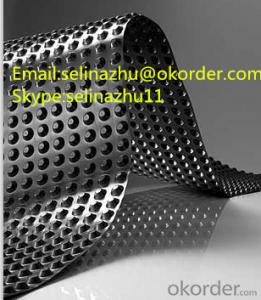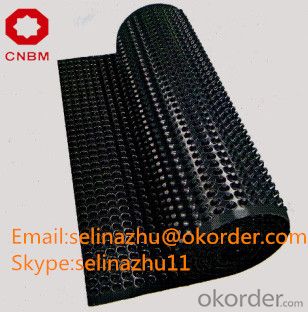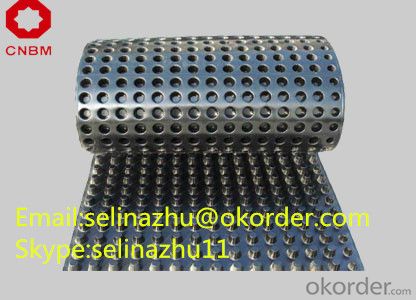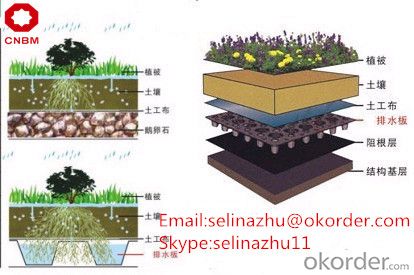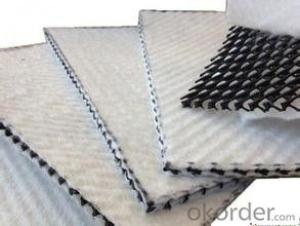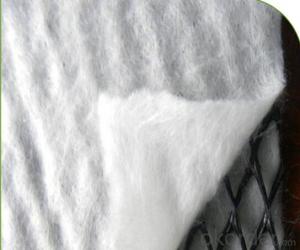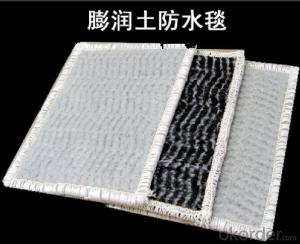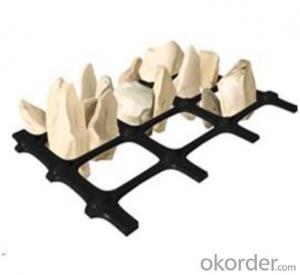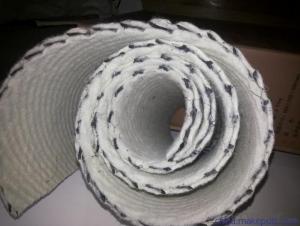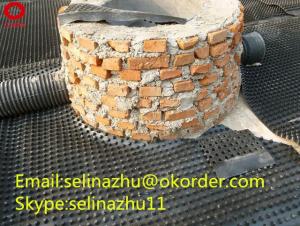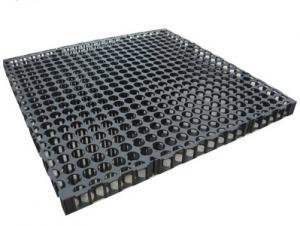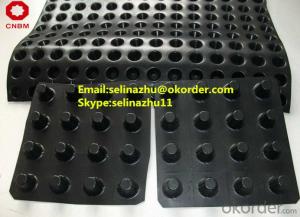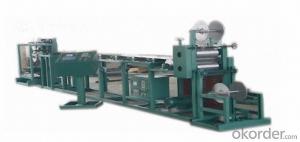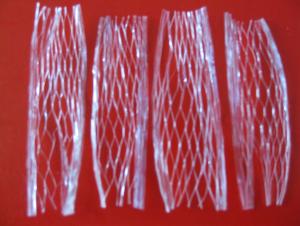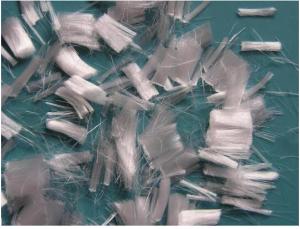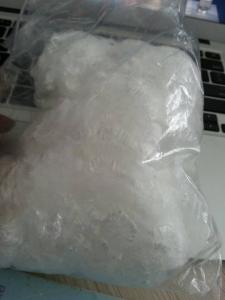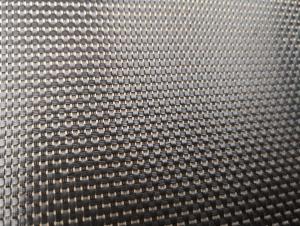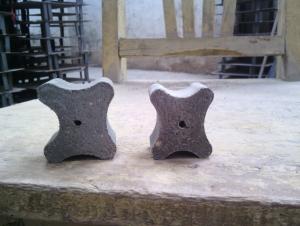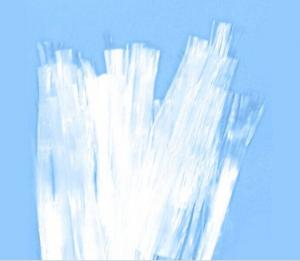Residential Drainage System Dimple Drainage board
- Loading Port:
- Qingdao
- Payment Terms:
- TT OR LC
- Min Order Qty:
- 3000 m²
- Supply Capability:
- 500000 m²/month
OKorder Service Pledge
OKorder Financial Service
You Might Also Like
Specification
Plastic Dimple Drainage Sheet Introduction
Plastic dimple drainage sheet is made of high molecular, produced by extrusion and adsorption. The tri-diamensional space can drain gas and fluid. It is multi-functional material, can form channels for water and gas easily, which is sound insulation and vibration isolation. In the field of civil construction can be widely used in building roof system layer overhead, planted roof drainage ventilation, basement waterproof system protection, thermal and moisture isolation of the interior surface, road and rail tunnel drainage protection. In the urban land, space, material resources are becoming scare today, plastic dimple drainage sheet to provide the most valuable option.
Plastic Dimple Drainage Sheet Application
Waterproofing system of road
Railway tunnel and underground
Basement of building
Roof garden
Other waterproofing and drainage construction works
Plastic Dimple Drainage Sheet Advantage
-Low cost, High efficiency
-Durable, anti age
-Chemical resistance
-Resistance to puncture of plant roots
-Diverse application
-Simple installation and quality guaranteed
Plastic Dimple Drainage Sheet Specifications
| No. | Item | Technical Index | |||||
| CMAX-H10-1.0 | CMAX-H20-1.0 | CMAX-H10-1.5 | CMAX-H20-1.5 | CMAX-H10-2.0 | CMAX-H20-2.0 | ||
| 1 | Board Thickness, mm | 1.0 | 1.0 | 1.5 | 1.5 | 2.0 | 2.0 |
| 2 | Depth of Dimple, mm | 10 | 20 | 10 | 20 | 10 | 20 |
| 3 | Tensile Strength, N/125px ≥ | 400 | 400 | 500 | 500 | 700 | 700 |
| 4 | Elongation at Break, % | 200 | 200 | 300 | 300 | 400 | 400 |
| 5 | Tensile Strength of Three-dimensional, Kpa | 400 | 320 | 450 | 370 | 500 | 420 |
| 6 | Dimension Stability, % | ±2 | |||||
| 7 | Low Temperature Bending | no creases in low temperature -35℃ | |||||
| 8 | Longitudinal Flow Capacity, cm3/s (water pressure 5KPa) | 5.6 | 8.6 | 5.6 | 8.6 | 5.6 | 8.6 |
| 9 | Longitudinal Flow Capacity, cm3/s (water pressure 350KPa) | 15.2 | 18.2 | 15.2 | 18.2 | 15.2 | 18.2 |
Plastic Dimple Drainage Sheet photos

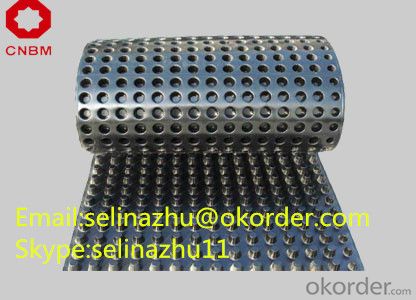
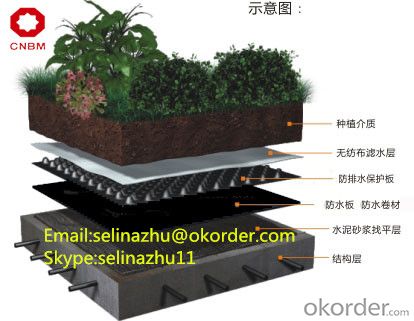
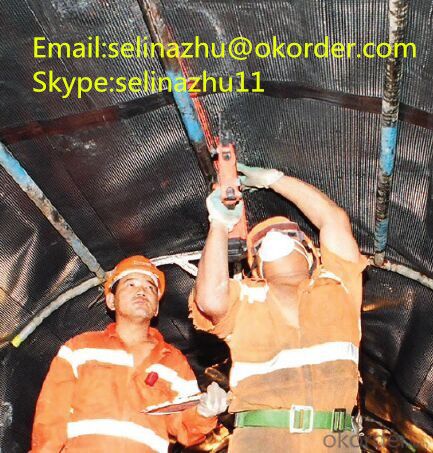
FAQ
1. Which payment do you accept?
For you convenience, our payment can be L/C, TT
2. Is free sample available?
We can supply free samples. You'll just need to pay for express cost.
3. Why choose CNBM?
CNBM is short for China National Building Material Corporation, is a China state owned huge corporation, exported from 1984. CNBM own the largest geosynthetics production base about 667000m2 in China and have about 120production line for all geo materials. For geotextile, we have 38 production lines, our production capacity each day can be 300,000m2.
We passed CE certificate and reaches ASTM standard, have more than 120 customers in EU, USA, Ocean, Africa and all markets. We’ll be your reliable partner in quality and after sales service.
3. How about your quality?
We have strict quality control system, we make testing on incoming raw material and finished products. Your third party testing is also welcomed. With high quality, our products are used on government projects at home and abroad. Our product quality is accepted by clients from all over the world. Warmly welcome your samples requirement or trail order.
- Q: What are the different types of geosynthetic reinforcements for tunnel construction?
- There are several types of geosynthetic reinforcements used in tunnel construction, including geotextiles, geogrids, and geocomposites. Geotextiles are permeable fabrics made from synthetic fibers that are used to separate, filter, and reinforce soil materials. Geogrids are high-strength synthetic materials in the form of grids or mesh structures, which provide tensile strength and soil confinement. Geocomposites combine the properties of geotextiles and geogrids, offering a combination of filtration, separation, reinforcement, and drainage capabilities. These different types of geosynthetic reinforcements play a vital role in improving the stability, structural integrity, and longevity of tunnels.
- Q: Are earthwork products cost-effective compared to other construction materials?
- Yes, earthwork products are generally considered cost-effective compared to other construction materials. Earthwork products, such as soil, sand, and gravel, are often readily available and can be sourced locally, which reduces transportation costs. Additionally, earthwork materials are often less expensive than other construction materials like concrete or steel. Moreover, earthwork products can be easily manipulated and compacted, making them versatile and efficient for various construction projects.
- Q: What are the key considerations when using geosynthetic reinforcements in bridge abutments?
- When using geosynthetic reinforcements in bridge abutments, there are several key considerations to keep in mind. Firstly, the strength and durability of the geosynthetic material is crucial. It should be able to withstand the loads and environmental conditions, ensuring long-term stability of the abutment. Secondly, proper design and installation techniques should be followed to ensure the geosynthetic reinforcement is placed correctly and securely. Adequate soil preparation and compaction are also important factors to consider. Additionally, the compatibility of the geosynthetic material with the surrounding soil and other abutment components should be evaluated to prevent any potential issues such as differential settlement. Finally, regular inspection and maintenance of the geosynthetic reinforcement should be carried out to detect any signs of damage or degradation and take timely corrective measures.
- Q: What are the benefits of using geogrids in mechanically stabilized earth walls?
- There are several benefits of using geogrids in mechanically stabilized earth walls. Firstly, geogrids provide increased stability and strength to the soil, allowing for the construction of taller and steeper walls. Secondly, geogrids distribute and reduce the lateral pressure exerted by the soil, minimizing the risk of wall failure. Additionally, geogrids improve the overall durability of the wall by preventing soil erosion and reducing the effects of settlement and lateral movement. Overall, the use of geogrids in mechanically stabilized earth walls enhances their performance and longevity.
- Q: Civil engineering graduation, after work which test is good?
- Civil engineering professional research types and conditions First, after graduation a year after the automatic conversion to assistant engineers, as assistant engineers after four years of assessment engineers. If you are engaged in the construction of the building on the construction division to do a certain time after the test of a supervision engineer. If you engage in the settlement of the test on the cost division or economist. If you engage in the design of the architect or architect or rock division. A supervisor of the supervision of the engineers. Of course, can more work to more test on the test. The supervisor of the maximum number of years so the final test budget, construction workers, quality inspectors, security officers, materials
- Q: Civil Engineering Materials. e Material saturated with water, and then dry the surface, is the hole filled with water or closed hole filled with water? What is the condition of putting the material in a jar filled with water? Not to say that the closed hole is not water?
- Civil Engineering Materials. e Material saturated with water, and then dry the surface, is the hole filled with water or closed hole filled with water? What is the condition of putting the material in a jar filled with water? Not to say that the closed hole is not water?
- Q: What are the different types of geotextile fabrics available?
- There are several types of geotextile fabrics available, including woven geotextiles, non-woven geotextiles, and knitted geotextiles. Woven geotextiles are made by weaving individual threads together, while non-woven geotextiles are manufactured by bonding fibers together through a mechanical or chemical process. Knitted geotextiles are produced by interlocking loops of yarn. Each type of geotextile fabric has its own specific characteristics and applications in various civil engineering and environmental projects.
- Q: Are earthwork products suitable for use in reservoir construction?
- Yes, earthwork products are suitable for use in reservoir construction. Earthwork products such as soil, clay, and gravel are commonly used in the construction of reservoirs to create embankments, dams, and slopes. These materials provide stability, prevent erosion, and help to retain water within the reservoir. Additionally, earthwork products can be engineered to meet specific construction requirements, making them an ideal choice for reservoir construction projects.
- Q: Civil engineering materials stone test, the determination of stone grade with what practical significance?
- Adjust the proportion of sand, stone
- Q: What are the different design options available for earthwork products?
- There are several design options available for earthwork products, including retaining walls, erosion control systems, slope stabilization techniques, and stormwater management solutions. These options can vary in terms of materials used, construction methods, aesthetic appeal, and functionality. Ultimately, the choice of design option depends on the specific site requirements, project goals, and budget constraints.
Send your message to us
Residential Drainage System Dimple Drainage board
- Loading Port:
- Qingdao
- Payment Terms:
- TT OR LC
- Min Order Qty:
- 3000 m²
- Supply Capability:
- 500000 m²/month
OKorder Service Pledge
OKorder Financial Service
Similar products
Hot products
Hot Searches
Related keywords
